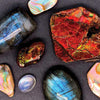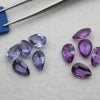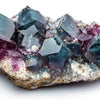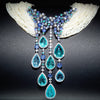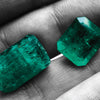Paraiba Tourmaline: The Neon Wonder of the Gem World
- by Greta Fontanella

Few gemstones have taken the jewelry world by storm as rapidly and dramatically as the Paraiba tourmaline. With an unearthly neon glow that seems to light up from within, Paraibas possess a presence that defies comparison. Their discovery revolutionized the world of colored stones, not just for their beauty, but for their rarity, geological uniqueness, and modern mystique.
In this article, we’ll explore everything you need to know about Paraiba tourmalines — from what gives them their glow to how to choose the right one for your jewelry.
A Recent Discovery with Legendary Impact
The story of Paraiba tourmaline begins relatively recently. In the late 1980s, a Brazilian miner named Heitor Dimas Barbosa became convinced that a new, extraordinary gem lay hidden beneath the rugged hills of Paraíba State, in northeastern Brazil. After years of painstaking digging, his intuition paid off.
In 1989, the first bright turquoise and electric-blue tourmalines were unearthed from the Batalha Mine, shocking the gem world with their unparalleled vibrancy. The jewelry market had never seen anything like it. Almost overnight, these copper-rich tourmalines — with their glowing blues and greens — became one of the most desirable gemstones on Earth.
What Makes Paraiba Tourmaline So Unique?
Most tourmalines come in a wide range of colors, but none exhibit the neon-like saturation of Paraiba tourmalines. The secret lies in their chemical composition.
Copper and Manganese: The Glow-Givers
Paraiba tourmalines are copper-bearing elbaite tourmalines. Unlike other tourmalines, they contain significant amounts of:
-
Copper (Cu) — responsible for the intense electric blue and green hues
-
Manganese (Mn) — often enhances or shifts tone toward violet or purple
The presence of copper was previously unknown in tourmaline, making this not just a new variety but a new gemological category.
These stones seem to glow even in low lighting, with a luminosity that has been compared to tropical waters, electric jellyfish, or bioluminescent organisms.
Color Spectrum and Rarity
While the classic “Paraiba blue” remains the most iconic, the range of colors includes:
-
Neon blue
-
Electric turquoise
-
Mint green
-
Seafoam green
-
Violet-blue and purplish tones
The most valuable colors tend to be pure, high-saturation blues with minimal green or gray, though green-leaning and even slightly lavender tones are also highly prized.
What makes Paraibas so rare is that this unique chemistry is incredibly difficult to replicate, even in nature. The combination of copper and manganese, combined with the right pressure, heat, and geological conditions, only occurred in a handful of locations on Earth.
Origin Matters: Brazil vs. Mozambique and Nigeria
Brazilian Paraiba
-
Mined in Paraíba and Rio Grande do Norte
-
Smaller crystals, but incredible color saturation
-
High value and collector demand
-
Often under 1 carat, but glow like they're lit from within
Mozambique and Nigeria
-
Discovered in the early 2000s
-
Larger crystals available, sometimes cleaner
-
Similar copper content and beauty
-
More affordable than Brazilian stones (but still expensive)
Gem labs distinguish between Brazilian and African Paraibas through advanced spectroscopy and chemical analysis. Brazilian stones often command 2–3 times the price of comparable African stones, purely due to origin and scarcity.
Lab Testing and Certification
Because of their high value, Paraiba tourmalines are frequently tested and certified. When purchasing a Paraiba, especially online or at high price points, insist on:
-
Gemological certification (GIA, AGL, GRS, IGI, etc.)
-
Confirmation that the stone is:
-
Tourmaline
-
Copper-bearing
-
Untreated or heat-treated (disclose fully)
-
-
Country of origin, if relevant
Note: “Paraiba” is now a trade name for copper-bearing tourmalines, not a guarantee of Brazilian origin.
Pricing and Investment
Paraiba tourmalines are among the most expensive colored gemstones per carat, even surpassing high-quality rubies, sapphires, and emeralds.
Key value drivers:
-
Color: Saturation, purity, and brightness
-
Origin: Brazilian > Mozambique/Nigeria
-
Clarity: Many Paraibas are included; eye-clean stones are rare and valuable
-
Carat size: Prices jump exponentially for stones over 1ct
-
Treatment: Heat treatment is common and stable, but untreated stones fetch more
Expect to pay:
-
$5,000–$10,000+ per carat for fine African stones
-
$20,000+ per carat for Brazilian stones
-
Top-quality stones can exceed $50,000 per carat
Paraiba in Jewelry: What You Need to Know
Because of their rarity and vividness, Paraiba tourmalines are often set in fine, high-end jewelry. They work beautifully as:
-
Center stones in engagement rings
-
Accents in halo rings, pendants, and earrings
-
Showpieces in one-of-a-kind couture designs
Jewelry Design Tips:
-
Protective settings (like bezels or halos) are ideal due to the stone’s fragility
-
Pair with white gold or platinum to highlight the neon glow
-
Try contrast with deep blue sapphires or white diamonds
Care and Cleaning:
-
Mohs hardness: 7–7.5
-
Avoid ultrasonic cleaners
-
Clean gently with lukewarm water, mild soap, and a soft brush
-
Remove during sports, manual work, or cleaning with harsh chemicals
A Collector’s Gem with Contemporary Appeal
In the world of colored gemstones, Paraiba tourmalines are a relatively new phenomenon, but they’ve already earned iconic status. Their vibrant tones appeal to modern designers and collectors looking for stones that stand out from the crowd — while their limited supply ensures they’ll only become more valuable over time.
Whether you’re seeking a high-impact engagement ring, a rare addition to your gemstone collection, or simply a conversation piece that feels alive, Paraiba tourmalines offer a level of intrigue that few other gems can match.
Summary
| Feature | Description |
|---|---|
| Mineral Type | Copper-bearing elbaite tourmaline |
| Hardness | 7–7.5 (Mohs) |
| Primary Sources | Brazil, Mozambique, Nigeria |
| Key Elements | Copper, manganese |
| Color Range | Neon blue, turquoise, mint green, violet-blue |
| Treatments | Usually heat-treated (accepted and stable) |
| Gem Value | Extremely high; often $10,000+ per carat |
| Use | Fine jewelry, collections, investment |
- Posted in:
- Brazilian paraiba
- copper tourmaline
- copper-bearing tourmaline
- electric tourmaline
- fine gemstone care
- gemstone investment
- high-end gemstones
- luxury gemstone jewelry
- Mozambique paraiba
- neon blue gemstone
- paraiba tourmaline
- rare gems
- tourmaline engagement ring
- vivid gemstone colors

